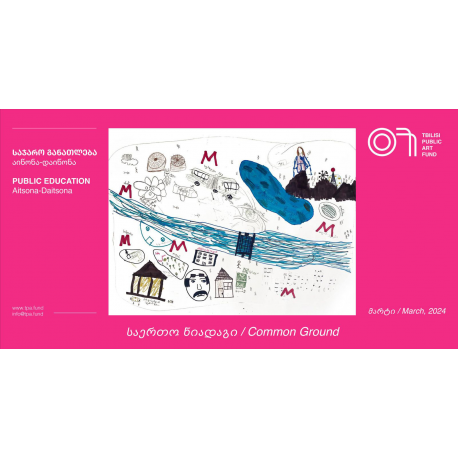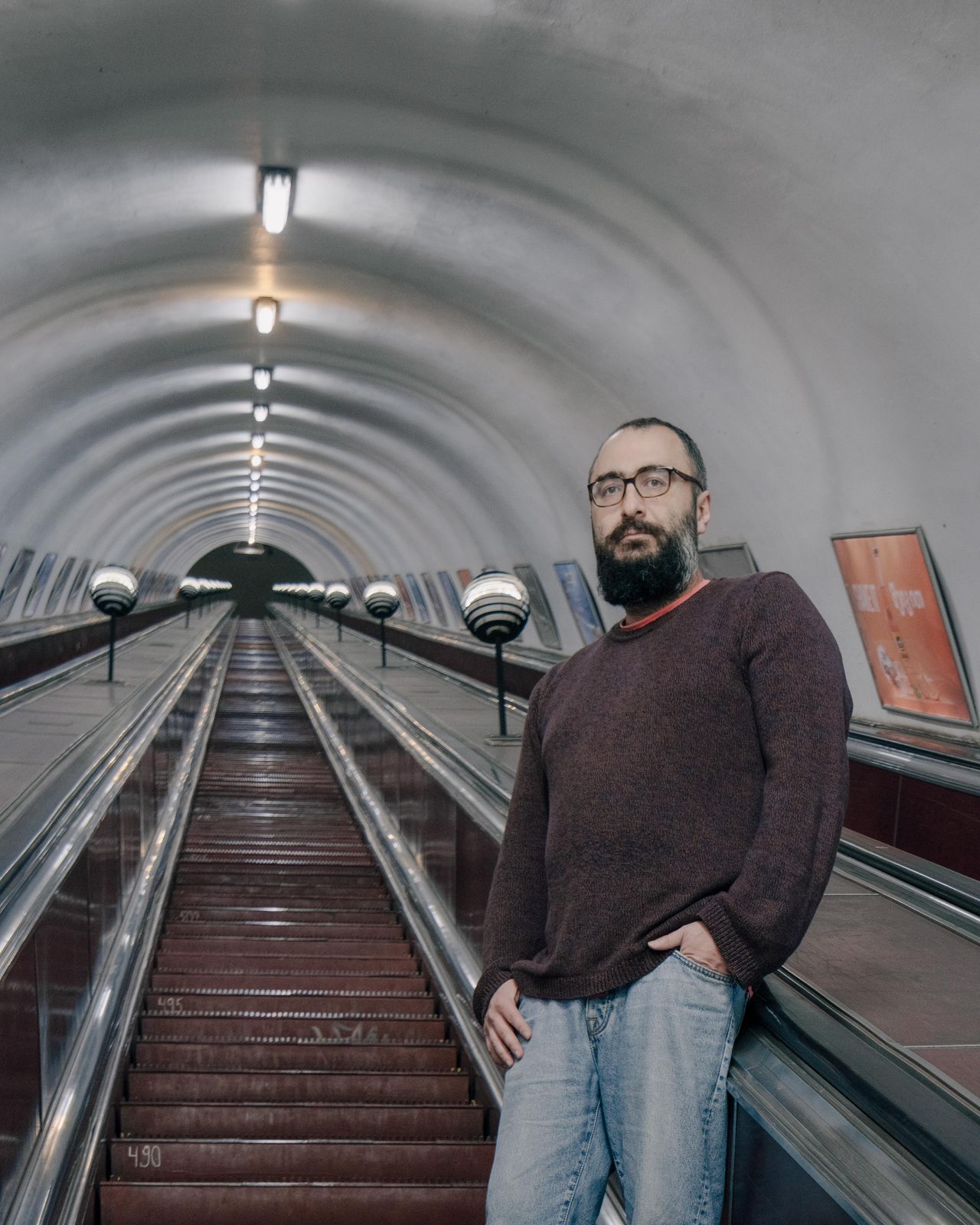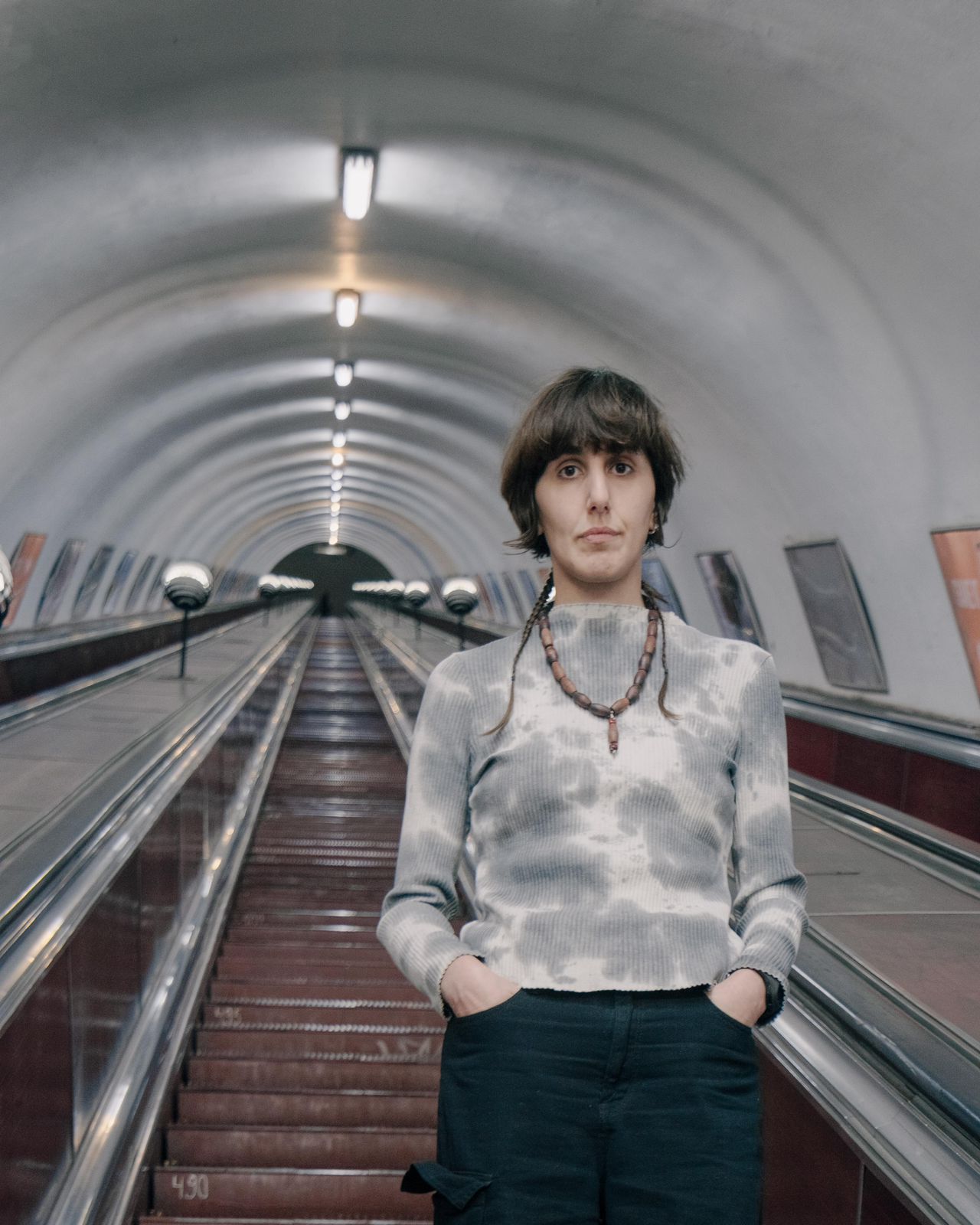 View larger
View larger

გია ხადური: საჯარო სივრცის მუსიკალური პერსპექტივები
= More info =
.jpg)
David Byrne in his book “How Music Works” develops the thought that musical results are shaped by the space in which this music sounds. Indeed, space and its atmosphere often dictate mood, ideology, direction, and even sound. To illustrate, he cites the case of punk music, which was fueled by the impulses of New York’s bohemian slum of the second half of the 70s, the East Village, and the club at its epicenter, CBGB, which fostered exactly the ambiance, controversial entourage, and noise that journalists dubbed punk. Punk, a potent genre to this day, in reality, was the soundtrack of a certain territory, a space, where a special atmosphere and chaos prevailed. The leading composer of American academic minimalism, Steve Reich, further believed that the development of classical music was determined by the spaces for which the sounding of symphonies or operas were intended, i.e. the so-called opera and ballet theater halls, still unequipped with microphones and thus with peculiar acoustic resources.
.jpeg)
Case in point, if we look at the history of music, just as important as the individual merits of composers or musicians, was the functional environment - the spaces for which this or that music was intended, plus, obviously, the technological innovations. The fact that the same music sounds differently in various spaces is probably spotted by every observant listener. To be more precise, different given areas call for a completely different sound and form of even the same music. In short, it can be safely said that any music is to some extent a soundtrack of the environment, of the reality where it is being conceived, developed, and initially played. Back in the day, all this used to be often intuitively, unaccountably interwoven, but it was clear that the intentional creation of an acoustic equivalent for a given space or environment was only a matter of time and technological advancement. And this is how sound sculpture edifices and sound installations appeared. This is already a case of deliberate acoustic reality created to fill the space and act as an accompaniment to the space, the impact of which is not as clear-cut and on the nose as a specific product conditioned to the ear, but it can unarguably affect the “consumer’s” consciousness, intelligence, aesthetic expertise or mood. It is an interesting point, that such an audio-acoustic result may not be considered functional music, but on the other hand, its flow too is directed toward human ears; It's just that it doesn't work in a generalized manner (this is not its immediate purpose either) but at a specific site - an exhibition space, be it for a certain category of viewer-listener, or the stream of people busy with their routine dynamics at a certain period of the day. I want to point out that for those artists who create work for a specific public routine space, the bar of creative challenge is set quite high as they can't choose the target audience, ultimately unable to give the audience a choice, thus binding them to their creation. In such a position, obviously, there is no guarantee that this audio-acoustic sound mass will act as effectively and positively as the author intended, there is no way. A successful result will not be unified either, clearly, not everyone will perceive music of such nature in the same way. Such music can even be unlistenable on its own, but fit the intended space directly or indirectly, organically mixing with the noise, dynamics, routine, and frame of mind that a specific space carries and gets occupied by different groups of people at certain periods. Yet another challenge - the work cannot be sounded in a way that everyone hears the same part, there is no static mode, and when one can stand and listen to the work from beginning to end, well, this is not an audio installation show, this is an art injection penetrating the daily street routine, every fragment of which should fit the space where it will sound. Based on all this, it is impossible to create such music that will be perfectly functional, now, the question of its aptitude, suitability, and adequacy to the location, often becomes the prerogative of intuition for the creator, as well as the reviewer and the chance consumer, this too, of course, without prior guarantees. Georgian musicians-artists who participated in the competition announced by the Tbilisi Public Art Fund faced exactly such difficult challenges. The competition aimed to reveal the best audio-musical installation, which would play in the interior space of Tbilisi Rustaveli metro station for 6 months. This competition was a part of a larger project initiated by the Tbilisi Public Art Fund whose objective is to transfer art from art spaces to public spaces. To the above-mentioned difficulties that musician-artists generally face when "stepping out" in public space, another specific challenge was added - how well the works submitted for the competition fit the interior space of particularly Rustaveli metro station. There are a large number of metro stations in Tbilisi, and all of them have their distinct characteristics, dynamics, ambiances, and functions. Together, all this reflects on passengers, who already view different metro locations distinctively, therefore, every station requires its soundtrack, to organically adapt the acoustic accompaniment, or atmosphere to the environment of a given metro building. Even the time of day when one encounters this acoustic reality, in the morning or the evening, while headed to a party, work, or returning, at a specific station is a key denominator. It is difficult for the authoring artist, and for the jury, to account for all of this, as the assessment criteria that will guarantee a more or less correct choice is almost impossible to grasp. Of course, all the jury members of this specific competition had their arguments. However, there was an applicant who came to be favored by almost everyone, but a little later on the details. For starters, it is noteworthy that the majority of the contestants, to an extent, considered the specifics of the particular location and the abiding status of Rustaveli metro station, and the standing of its interior section, the tunnel in which escalators move; Also took into account that the passenger, consumer, and potential listener are simultaneously in a static (standing on the escalator) and in a mobile state (escalator movement, going up and down); They also bore in mind the moment (at least a few tried) that the movement of the passenger to sync with the sound mass that this passenger comes in contact with, and moreover that the music will be practically exposed only for 3 minutes perhaps, approximate time needed to reach the platform via escalator and vice versa. One point is key here if the submitted tracks had been evaluated as objectively the best musical work, the results would have differed, but the matter of fact is that the evaluation criteria were dictated by the Rustaveli metro space and the probable perception of the mixed mass of people passing through it, which more-so parteins to imagination than logic. Weighting the reaction of the masses and guessing their acceptance, of course, cannot be ideal in any sense, that's why this project had an experimental character, only lasting for 6 months, and it would demonstrate - how much the final choice would coincide with the people’s reception, who systematically, fragmentarily, or just once encounter the selected music on the escalators of the Rustaveli metro station. Actually, monitoring this too is an unachievable task, to determine general attitude-reaction — somewhat possible. The jury was not aware of the contestants’ identities, they looked at the adequacy of the result and not the artist, so it was necessary to name 3 winners to keep a wider acoustic spectrum.
.jpeg)
1. The work of "Tornike", in its form and content, is well suited to the specific functional area for which it is intended; Simultaneously at hand are both dynamism and stagnancy. The work is built on the looped musical phrase from the Georgian folk chant, a male and female voices are heard, alternating. This phrase is processed with echoes and reverberations in such a fashion that it is difficult to speculate on a specific familiar pattern, it generalizes, which conceptually and acoustically sharply suits the metro station named after Rustaveli. There is sacredness, mysticism, and ephemerality of a distant epoch. It would probably not flatter the escalators of the Marjanishvili metro as much. Chants are generally heard in a temple, on the other hand though, a metro tunnel can produce the same acoustic resonance, and these two irrational-rational aspects are acutely combined. Via the use of electronics, all this"archaic" flow is processed in a way that it is emphasized - it happens "today" and "here" and could not have happened "yesterday" and "there". Such "chanting" is accompanied by a sound collage, which is in this instance completely electronic synthetic and serves as a certain counterpoint between the old and the new, between the territorial-anthropological-native and the transglobal-futuristic. The idea is clear — to deliver the ethnic-traditional vocal-sample segment in such a way that it goes beyond the anachronistic context, and updates with current pulsation and remix. The author does not aim to throw passenger-consumers into the national sound comfort by any means. In today's existentially rocky, anxious, and turmoil-heavy life, the emphasis on the pleasures of listening is unauthentic and complacent. This work raised the question of another potential difficulty. The thing is that getting on and off the metro comes with a specific internal state - when one gets on the escalator to access the platform, it’s as if one detaches from the stresses that have accumulated outside, of course, temporarily, but the relaxation notes are indeed there, and time as well, seems to stop underground. Considering this nuance, the 2 main constituent elements of Tornike's work, "cleansing Georgian chant" and its "electric tormenting accompaniment", miss each other in the context of impact, that is, they are less appropriate to the tenor of the listening passenger. On the other hand, when you are already coming up the escalator and feel the nearing snapping out from this calm environment to the "abnormal" outside world, then the contradictory "suspense" of this work is relatively accurate. So, descending is one circumstance, ascending is another, and they often do not coincide with each other, but the audio installation cannot be differentiated; well, in the space at hand, it plays on the specially installed "speakers" between escalator lamps, right?! Specifically, in the case of Tornike's piece, during the descent, it would be good to lower the intense electronic sound accompaniment and focus on the "chanting", during the ascent, on the contrary, this is of course not feasible. I think in such instances it is ideal to effectuate such a monolithic acoustic mass, that it becomes difficult to separate the constituent elements of the musical stream at the moment of entering the ears of the listeners, the "disintegration" into elements should take place "post factum" in the consumers' heads. Depending on what process one is in, what mood, what aesthetic experience they have, whether one is old-fashioned or trans-progressive, liberal or conservative (all kinds of people walk in the metro), this process will be individual for everyone, which is a problem, although resolving all issues is impossible when moving escalators of the metro are selected as the sounding site of the music. I assume Tornike's work in its perspective would have worked independently more effectively than as a soundtrack of the space of the metro tunnel, but the author even accounted for the brief duration of the passenger’s stay on the escalator and ensured a time-informed formatting of the pattern. The consumer can manage to catch all the acoustic messages that intersect in the track. When the same consumer ends up in the same space for the second, third, or seventh time and runs into Tornike’s installation again, obviously, they will not run into the exact section experienced previously. The music is one, and although it lasts 17 minutes the compositional core amounts to only a few minutes, which permanently repeats, but the tone of the sounds changes, so that with each subsequent cut you hear the same music, but arranged differently. The result is a confrontation with the familiar-unfamiliar acoustic reality several times, which leads to a better understanding of the essence of the work, which is quite a well-founded approach, apt for such a project.

2. Nika Japaridze's winning composition is a work instrumentalizing circulating sound waves. The acoustic flow is agile, the sound forms are rounded, and the ambient-synthesizer field is more imbued with the aesthetics of an instrumental piece, let’s say, even if a live band would perform it well, so unlike Tornike, Nika Japaridze's musical reality is more tangible, harmonious, more authorial, more soundtrack-like, would even suit a visual installation or moving image as an audio accompaniment. These dotted sound notes also evoke a certain positive feeling. From this point of view, this work is more functionally specific, deliberately considering the general psychological state of the passenger audience, specifically in the metro space. The supposed time delay effect is also achieved rhythmically accurately, more static, and less sound-tormenting. I wrote above that it is an authorial work, but it is also depersonalized, as it has transparent acoustics. Based on the specifics of the work, the function, and the author's choice as well, I think the sound should have been more balanced. Mixing and mastering could have been more diligently ambient, where the sound facets that are leveled at the beginning should not be intersected at all, but as you listen you gradually start to notice that what was smooth, becomes rough, more precisely, that is how it gets processed in the listener's head. Monotony is the most noticeable fault here, it even gradually becomes boring, or to be more precise, the charm is lost. It seems that the aspect of considering the internal state of the consumer is also lost gradually. In general, this track provokes contradictory opinions, for example - the fact that the music turns trivial at some point even becomes an ace of trumps of the work, as it serves to increase the track’s potential to manifest what the average statistical consumer, listener, passenger wants, and this is felt. Impressions change throughout the hearing process. It is obvious when you listen to a track of this nature for 10 minutes is one thing, and when you listen to it for only 2-3 minutes, it is completely different and therefore, not as tiring, but when you listen to it for the second, third time, this audio music stream can start feeling annoying. Practically, this work is more suitable for those who will find themselves on the escalators of the Rustaveli metro only once or twice during those 6 months. And yet, how well aimed is the mood and atmosphere of this audio piece specifically for the Rustaveli station? And not for the station square as an example or the technical university? Well, that already is a topic of discussion. In my opinion, it is less appropriate for Rustaveli, however, this is the moment when the truth should be determined using an empirical method, in other words, how it will perform its task in reality. The type of associations the music evokes when experiencing it in a stand-alone setting may not be correct and adequate in this case. Personally, it gave me the impression of a musical work designed to fill a space emptied of people, where everything is slowed down and inert, or if the night shift brigade starts checking the metro tunnel, well, one can come up with a lot of interpretations. Nika Japaridze's minimalist work does provide such a resource. It would go well with some thematically relevant video footage, but who knows?!

3. Nino Davadze's composition became the absolute favorite of the jury, which is well within logic. It's rare to find someone today who has as good a sense of context as Nino. Motivation, why she does what she does, and how she does it based on the task and the format of the piece, or what it is intended for and even for whom, and all this she grounds on a conceptual basis, idiosyncratically, originally, and even with risk. Nino is from Kharagauli and tried to introduce naturalistic elements of nature into the urban space, which are absolutely distanced and foreign from the neuroses and disquiet of the city. Even if for a few minutes a person worn out from routine may feel that they are also a child of nature, an organic part of it, and much more than simply the unconditional property of urbanism. Her female choirs resemble the sounds of sirens from the forest, and besides, this borrows from real space, right?! Borjomi-Kharagauli National Park is her native area, where there is a completely contrasting rhythm and a much different pace. It is interesting that this rhythm perfectly matches the sluggish rhythm of the escalator stream, moreover, it seems to be fused in its dynamic. Practically, a march through an acoustic forest comes about, that is both magical, surreal, and tangible in its utmost authenticity. She rather consciously divided the work into two parts, evening and morning, the morning is truly a morning - the chirping of birds wakes you up, gives you energy, and the stimulus that should pour into you without your involvement. Her music is not pattern looping, it's more of an acoustic adventure, absolutely sheer. It is not an ambient in its form, it is more of an acoustic self-sufficient landscape, enriched with slightly obscure sound and unrecognizable noises, which keeps you from falling into the charm and euphoria; It's morning, a sober state, although with a backdrop of emotional serenity. The energetic chirping of birds - all this seems a little surreal for a specific space from one viewpoint, in fact, it does exist here, somewhere, next to us, an hour or two away. The acoustic flow in which you are entangled - also seems as though is objectively in nature, which the author simply found and arranged for those people who, in the morning and evening, face the most overcrowded urban, neurotic part of this city, in the symbolic space of the Rustaveli metro station, in the tunnel, moving in a non-stop mode, standing on the escalators, and surrounded by an ever-changing mass of people. It is a very accurate finding, simultaneous distancing, and close contact, curiosity arousing. Curiosity - is, in fact, the key definition, both for Davadze's work and for understanding the purpose of the project, a state in which, whether one likes it or not, everyone will automatically fall into who will encounter, run into, communicate with or become alienated from the acoustic atmosphere which will be stationed alternately for 6 months filling the metro space.
.jpeg)
With curiosity begins the knowledge of everything, the accumulation of knowledge, intelligence, art, and even spiritual values, curiosity birthed civilization and progress, and the idea of this particular project, serves to arouse curiosity in the consciousness of our fellow citizens — to bring art outside of set boundaries and make it as accessible as possible to the masses.





